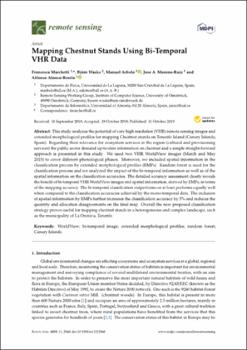Mapping Chestnut stands using bi-temporal VHR data
Fecha
2019Resumen
This study analyzes the potential of very high resolution (VHR) remote sensing images and
extended morphological profiles for mapping Chestnut stands on Tenerife Island (Canary Islands,
Spain). Regarding their relevance for ecosystem services in the region (cultural and provisioning
services) the public sector demand up-to-date information on chestnut and a simple straight-forward
approach is presented in this study. We used two VHR WorldView images (March and May
2015) to cover different phenological phases. Moreover, we included spatial information in the
classification process by extended morphological profiles (EMPs). Random forest is used for the
classification process and we analyzed the impact of the bi-temporal information as well as of the
spatial information on the classification accuracies. The detailed accuracy assessment clearly reveals
the benefit of bi-temporal VHR WorldView images and spatial information, derived by EMPs, in terms
of the mapping accuracy. The bi-temporal classification outperforms or at least performs equally well
when compared to the classification accuracies achieved by the mono-temporal data. The inclusion
of spatial information by EMPs further increases the classification accuracy by 5% and reduces the
quantity and allocation disagreements on the final map. Overall the new proposed classification
strategy proves useful for mapping chestnut stands in a heterogeneous and complex landscape, such
as the municipality of La Orotava, Tenerife






